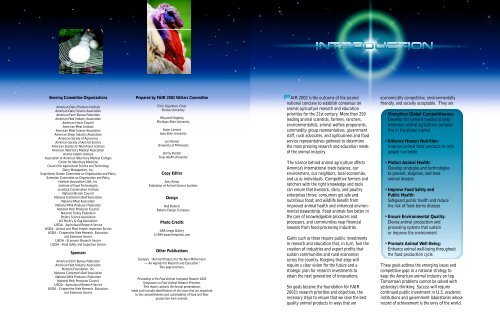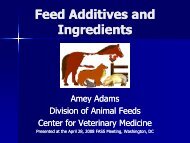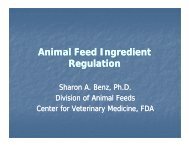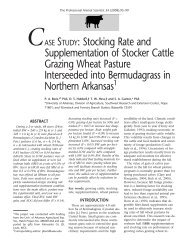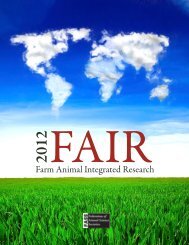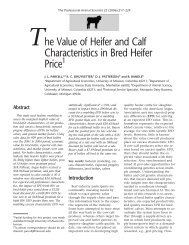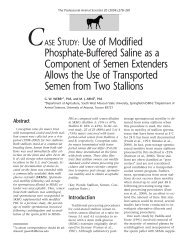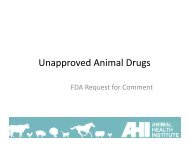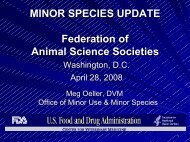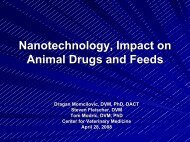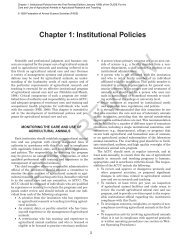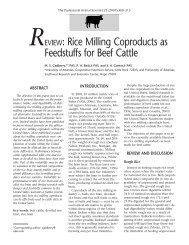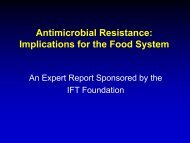Fair 2002 - Federation of Animal Science Societies
Fair 2002 - Federation of Animal Science Societies
Fair 2002 - Federation of Animal Science Societies
You also want an ePaper? Increase the reach of your titles
YUMPU automatically turns print PDFs into web optimized ePapers that Google loves.
Steering Committee Organizations<br />
American Dairy Products Institute<br />
American Dairy <strong>Science</strong> Association<br />
American Farm Bureau <strong>Federation</strong><br />
American Feed Industry Association<br />
American Horse Council<br />
American Meat Institute<br />
American Meat <strong>Science</strong> Association<br />
American Sheep Industry Association<br />
American Society <strong>of</strong> Agronomy<br />
American Society <strong>of</strong> <strong>Animal</strong> <strong>Science</strong><br />
American Society for Nutritional <strong>Science</strong>s<br />
American Veterinary Medical Association<br />
<strong>Animal</strong> Health Institute<br />
Association <strong>of</strong> American Veterinary Medical Colleges<br />
Center for Veterinary Medicine<br />
Council for Agricultural <strong>Science</strong> and Technology<br />
Dairy Management, Inc.<br />
Experiment Station Committee on Organization and Policy<br />
Extension Committee on Organization and Policy<br />
Holstein Association USA, Inc.<br />
Institute <strong>of</strong> Food Technologists<br />
Livestock Conservation Institute<br />
National Broiler Council<br />
National Cattlemen’s Beef Association<br />
National Meat Association<br />
National Milk Producers <strong>Federation</strong><br />
National Pork Producers Council<br />
National Turkey <strong>Federation</strong><br />
Poultry <strong>Science</strong> Association<br />
US Poultry & Egg Association<br />
USDA - Agricultural Research Service<br />
USDA - <strong>Animal</strong> and Plant Health Inspection Service<br />
USDA - Cooperative State Research, Education,<br />
and Extension Service<br />
USDA - Economic Research Service<br />
USDA - Food Safety and Inspection Service<br />
Sponsors<br />
American Farm Bureau <strong>Federation</strong><br />
American Feed Industry Association<br />
Holstein Foundation, Inc.<br />
National Cattlemen’s Beef Association<br />
National Milk Producers <strong>Federation</strong><br />
National Pork Producers Council<br />
USDA - Agricultural Research Service<br />
USDA - Cooperative State Research, Education,<br />
and Extension Service<br />
Prepared by FAIR <strong>2002</strong> Writers Committee<br />
Chris Sigurdson, Chair<br />
Purdue University<br />
Maynard Hogberg<br />
Michigan State University<br />
Susan Lamont<br />
Iowa State University<br />
Les Hansen<br />
University <strong>of</strong> Minnesota<br />
Jimmy Keeton<br />
Texas A&M University<br />
Copy Editor<br />
Amy Kemp<br />
<strong>Federation</strong> <strong>of</strong> <strong>Animal</strong> <strong>Science</strong> <strong>Societies</strong><br />
Design<br />
Rod Roberts<br />
Roberts Design Company<br />
Photo Credits<br />
ARS Image Gallery<br />
©1999 www.farmphoto.com<br />
Other Publications<br />
Synopsis. “<strong>Animal</strong> Products for the Next Millennium<br />
— An Agenda for Research and Education.”<br />
Two-page brochure.<br />
Proceedings <strong>of</strong> the Food <strong>Animal</strong> Integrated Research <strong>2002</strong><br />
Symposium on Food <strong>Animal</strong> Research Priorities.<br />
This report contains the formal presentations<br />
made and includes identification <strong>of</strong> the issues that are important<br />
to the competitiveness and sustainability <strong>of</strong> food and fiber<br />
production from animals.<br />
F<br />
AIR <strong>2002</strong> is the outcome <strong>of</strong> the second<br />
national conclave to establish consensus on<br />
animal agriculture research and education<br />
priorities for the 21st century. More than 250<br />
leading animal scientists, farmers, ranchers,<br />
environmentalists, animal welfare proponents,<br />
commodity group representatives, government<br />
staff, rural advocates, and agribusiness and food<br />
service representatives gathered to determine<br />
the most pressing research and education needs<br />
<strong>of</strong> the animal industry.<br />
The science behind animal agriculture affects<br />
America’s international trade balance, our<br />
environment, our neighbors, local economies,<br />
and us as individuals. Competitive farmers and<br />
ranchers with the right knowledge and tools<br />
can ensure that livestock, dairy, and poultry<br />
enterprises thrive; consumers get safe and<br />
nutritious food; and wildlife benefit from<br />
improved animal health and enhanced environmental<br />
stewardship. Food animals fare better in<br />
the care <strong>of</strong> knowledgeable producers and<br />
processors, and communities reap financial<br />
rewards from food-processing industries.<br />
Gains such as these require public investments<br />
in research and education that, in turn, fuel the<br />
creation <strong>of</strong> industries and export pr<strong>of</strong>its that<br />
sustain communities and rural economies<br />
across the country. Keeping that edge will<br />
require a clear vision for the future and a<br />
strategic plan for research investments to<br />
attain the next generation <strong>of</strong> innovations.<br />
Six goals became the foundation for FAIR<br />
<strong>2002</strong>’s research priorities and objectives, the<br />
necessary steps to ensure that we raise the best<br />
quality animal products in ways that are<br />
economically competitive, environmentally<br />
friendly, and socially acceptable. They are<br />
• Strengthen Global Competitiveness:<br />
Develop the systems needed to keep<br />
American animal agriculture competitive<br />
in the global market<br />
• Enhance Human Nutrition:<br />
Improve animal food products to help<br />
people live better<br />
• Protect <strong>Animal</strong> Health:<br />
Develop strategies and technologies<br />
to prevent, diagnose, and treat<br />
animal diseases<br />
• Improve Food Safety and<br />
Public Health:<br />
Safeguard public health and reduce<br />
the risk <strong>of</strong> food-borne diseases<br />
• Ensure Environmental Quality:<br />
Devise animal production and<br />
processing systems that sustain<br />
or improve the environment<br />
• Promote <strong>Animal</strong> Well-Being:<br />
Enhance animal well-being throughout<br />
the food production cycle.<br />
These goals address the emerging issues and<br />
competitive gaps in a national strategy to<br />
keep the American animal industry on top.<br />
Tomorrow’s problems cannot be solved with<br />
yesterday’s thinking. Success will require<br />
continued public investment in U.S. academic<br />
institutions and government laboratories whose<br />
record <strong>of</strong> achievement is the envy <strong>of</strong> the world.


